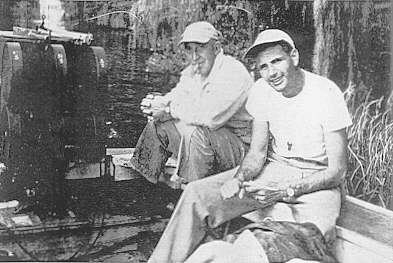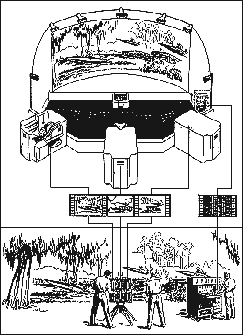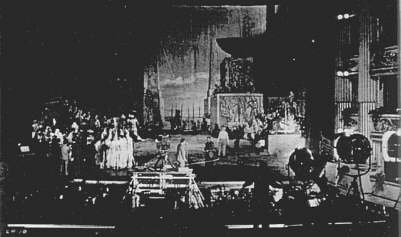This article, provided by David Mullen, was published in the November, 1952 issue of American Cinematographer. No other development in motion picture technology, including color and sound, had as much immediate impact on the film industry and the expectations of the film going public as did Cinerama. Within days of the premiere of This Is Cinerama the studios were scrambling for something that would do what this process, which they'd all rejected, had done. If you have never seen real Cinerama, I cannot recommend strongly enough that you take a trip to Dayton, Ohio, or Bradford, England, and see it for yourself.
MBH
DIAGRAM shows course of a Cinerama film production from camera to projection. At bottom, scene is photographed with three-lensed camera, which records scene on three separate 35mm films. In projection, films are screened by three projectors-one in center and one at each side. The three film images become one on the large horizontal curved screen, and give the illusion of multi-dimensional reality without recourse to Polaroid spectacles. Stereophonic sound is recorded magnetically through five or more mikes, which produce a multiple sound track. This is reproduced through a like number of speakers which surround the screen.
Just as sound changed the course of motion pictures 25 years ago, Cinerama promises to broaden the scope of feature films. What it is and how it works is described here by one who witnessed its New York premiere.
By JOHN W. BOYLE, ASC
THE LONG HERALDED Cinerama made good at its first public presentation last month at the Broadway Theatre in New York City. The successful premiere showing marked another of those periodical innovations which have punctuated the history of the motion picture industry over the years, and like the others before it, is destined to have a major effect on its future.
As was everyone else in the motion picture industry who attended the premiere of Cinerama, I was tremendously impressed with its possibilities. Cinerama is not a stereo film system, nor does its inventor call it a three-dimension system. It is, instead, a means of bringing vastness to the screen without distortion or loss of definition and to create a sense of space through a larger, new type of screen, which fills the proscenium arch of the theatre. Sir Alexander Korda has described it most aptly as ". . . one of the most important inventions in the history of films. It gives the complete illusion of three dimension effects in color and sound without the use of glasses."
Lowell Thomas, one of the important men associated with the new process describes Cinerama as "an adventure with a new medium which I believe will revolutionize the technique of motion picture story telling. From the beginning, pictures have been restricted by space. A painting is hemmed in by its frame, so to speak. Conventional motion pictures are confined to a narrow screen. You see only what is straight ahead, while normal vision includes what you see out of the corners of the eyes. Someone has said that movies are like looking through a keyhole. Cinerama breaks out of the sides of the ordinary screen, and presents nearly the scope of normal vision and hearing."
Cinerama is the result of a brilliant idea, 15 years of untiring research and the expenditure of millions of dollars. Its inventor Fred Waller, developed the now famous gunnery trainer used in the armed forces in World War II. It saved an estimated 350,000 casualties. In it, four trainees sat in a large room in front of a huge spherical screen on which five synchronized projectors threw movies of enemy planes that dove on the novice gunners every which-way.
In a realistic three-dimension atmosphere, each gunner fired an electronic machine gun at his adversaries. The gun recorded the hits instead of firing bullets. This Waller trainer was the final step along the road to Cinerama.
The theory behind it dates back to Waller's early days when, as head of Paramount Studios trick film department, he produced everything from realistic model shipwrecks to convertible carriage pumpkins for Cinderella. Waller figured that if he could devise cameras and projectors that would duplicate most of the normal vision as seen by a pair of human eyes, the human brain would do the rest. His first camera was an eleven-lensed monster which produced film for eleven matching projectors to throw on a curved screen. "It was crude," says Waller, "but it gave the audience an experience, and I knew I was on my way."
The illusion of reality created by Cinerama is closely linked to the functions of the retina of the human eye and the drum of the human ear. The film process attains the effects of real life by surrounding the viewer completely with action and sound in an environment. The picture Cinerama produces is almost a complete half-circle, 146 degrees wide and 55 degrees high-pretty close to two human eyes which cover about 180 degrees and 90 degrees. Naturally, no lens known can cover such a field without excessive distortion. Hence, the Cinerama camera has three 27mm lenses-no bigger than the lens of your own eye - set at 48 degrees angle. Each records a third of the picture’s total width as seen on the screen, exposing its own strip of 35mm film. The lenses are arranged on a special mount in the camera like a miniature three-section picture frame. The one in the center points straight ahead. Those on each side point in, so that the left lens records the right side of the picture and the one on the right takes the left side. A single, rotating shutter, that whirls in front of the lenses at the point where their lines of view cross, makes foolproof simultaneous exposures on each of the films. Diaphragm controls adjust settings on all three lenses simultaneously.
Individual Cinerama film frames are one-half again standard height-in other words, 6 perforations high instead of the standard four-and since three film strips are used. this means that the total amount of film used is 4 1/2 times as much as normally used in filming a standard 35mm feature production. To merge the three film strips into a single picture on the screen, measuring 51 feet in width and 25 feet high, the process is reversed. Three 35mm projectors in separate booths throw the images from each film out onto the screen. The projector on the right fills the left third of the screen; the one on the left, the right third; and the one in the center fills the center portion. Since the screen is curved, one would naturally expect distortion and fuzziness to result; but this does not happen. Great depth of focus of the projector lenses keep the picture sharp. Distortion, caused by reflected light bouncing off the screen. is licked by the screen's special design which is made up of 1100 overlapping vertical strips of perforated tape set at angles like the slats of a vertical Venetian blind, instead of the one-piece screen used in conventional motion pictures. Reflected light bounces off a strip and escapes behind the strip directly in front of it.
One of the problems that had to be overcome in the development of Cinerama was how to put the images of three separate film strips on the screen side by side without lines of demarcation showing between them. This problem was solved by what technicians call "gigolos" -tiny gadgets that look like combs having teeth along one edge. These are fitted on each projector on the side of the film track and jiggle up and down along the edges of the picture area of the film at high speed. These little saw toothed "dodgers" diffuse the edges of the three Cinerama film images where they join on the screen, blending them together at the margins without a conspicuous dividing line. Incidentally, the oversized reels which feed film to each of the three Cinerama projectors hold 7,500 feet of film, which runs up to 50 minutes on the screen.
The stereophonic sound that heightens the realistic illusion of Cinerama is as new and unusual as the visual effect. When a Cinerama production is being photographed, five microphones are placed to pick up the sound in different areas of the scene. One to three others are placed well off to one side, or behind the camera, to pick up the sound of people’s voices, roaring engines, or whatever may be approaching or leaving the scene. Each microphone leads to recording head on the master multiple magnetic film recorder set up usually near the camera. This sound is reproduced in the theatre through five speakers arranged behind the screen- one for each of the sound tracks recorded from the set. Other speakers are placed on the walls of the theatre and, another at the rear. Each speaker thus reproduces the sounds picked up by the individual mikes at a point corresponding to its position during filming, and thus produces the unusual effect of realistic sound which is an important feature of Cinerama. When a motorboat, for instance, roars across the screen, the noise of its engine begins as the boat merges on the screen from one side, and continues coming from the position of the boat as it travels to the other side.
Title of the initial public presentation of Cinerama is "This Is Cinerama", filmed in Technicolor, it comprises a number of non-related subjects - a sort of melange of short subjects each complete in itself - and include, The Roller Coaster, A Ballet, The Fourth Wonder of the World, Handel's 'The Messiah', Venetian Boatmen, Kilts and Tartans, Toreador, Spanish Rhythm, The Vienna Boys Choir, The Finale from Act II of ‘Aida’, Rare Beauty and Fast Action, and America The Beautiful.

HARRY SQUIRE, cameraman, (left) and Bob Bendick (right) co-producer of "This Is Cinerama", which introduces the wonders of the new Cinerama process to the world, pose briefly before photographing a scene with the special 3-lensed Cinerama camera, show at far left. Note the three film chambers which hold the three separate films used in Cinerama photography: also the gunsight finder at top of camera used in keeping the camera centered on long shot action.
Harry Squire is Cinerama's cameraman. There will be others, of course, as Cinerama develops and expands; but Squire is the man who worked as avidly as Fred Waller to make Cinerama a pictorial success. The photography of "This Is Cinerama" is a story in itself, and we hope Harry Squire will write for early issue of American Cinematographer. He isn't what you'd call quiet and retiring, yet today, after the tremendous work and the multitude of experiences he has encountered putting action on Cinerama film, Squire says simply, "It's all routine to me." But the material he photographed for Cinerama's initial public presentation is far from routine stuff, as the reader will see should he be lucky enough to witness a screening of this initial Cinerama production.
Squire found there weren't enough lights in Italy to illuminate the stage in filming La Scala Opera Company's brilliant presentation of the "Aida" score in an Italian theatre; additional lights had to be flown in from England, along with extra generators. He mounted his heavy Cinerama camera on the bow of a speedboat to capture thrilling footage of water sports in Florida. To film water-level shots of press Gardens' lovely Aquabelles, Squire had his crew cut a canoe in half, mounted his Cinerama camera on a platform attached to the open end of the front section. A special camera scaffolding was built in one of the Cypress Gardens lagoons so that the outboard motor boats could come into the scene from beneath the camera. Cinerama photography presented new and interesting problems, none of them difficult - all of them challenging.
FILMING one of the scenes from "Aida" performed by the world renouned LaScala Opera Company in Milan, Italy, for a sequence in "This Is Cinerama." The three-lensed camera is mounted on the parallel in center foreground. There were not enough studio lights in all Italy to illuminate the huge stage for color film, so additional lights and generators were flown to Italy from England.
Since Cinerama's public debut, there has been tremendous interest generated in this new motion picture innovation. Those who have not yet witnessed it on the screen quite naturally ask about its future, what its effect will be on the motion picture industry. What, if anything, will it do to change motion picture photography in general, and if it can be applied to television.
It is not likely that Cinerama will play a part in television films for sometime to come. Nor is it likely to replace general feature film production. Cinerama is in a class by itself. Its level is in the field of the super-spectacle film production. Its extreme wide angle screen is not ideal for the tight closeups we now see in dramatic films. Cinerama demands stories of great action and pictorial scope. Such pictures as "Quo Vadis." "The Greatest Show on Earth," "Ivanhoe" etc., would have been tremendous Cinerama presentations.
Interest in Cinerama is likely to continue at a high level with industry heads waiting the day it can turn a profit for theatres. James Jerauld, writing in "Boxoffice" for October 11, 1952, said:
"Money-lots of it-is required. A three-camera filming unit, in addition to the regular camera crew in studios, could triple print costs. This wouldn't be an insuperable objection if the public should respond. On the other hand, six projection machines in three booths, six operators on duty in places where two men in a booth are required, and the first cost of installation running up to $75,000 could fill an exhibitor with alarm.
"How to focus attention on one or two or three or four actors in dramatic productions when the screen is the width of the theatre is something else that will require study. When Magnascope was introduced with 'Old Ironsides' about 25 years ago, the screen was suddenly enlarged by pulling back drapes and then closed again with the same speed for the regular lenses. It may be possible to do this with Cinerama.
"Most exhibitors will watch developments with open minds."
The addition of Louis B. Mayer to the Cinerama organization has accelerated interest in the process. It is reported that most of the major Hollywood studios have made inquiries about utilizing it. Since Cinerama, Inc ., owns all patents, it would be leased to studios.
Just how Cinerama presentations will be set up throughout the country has not been decided. There have been hints that the company would operate its own theatres. It now has equipment sufficient to operate three. At present, installation cost of equipment for Cinerama showings in theatres costs from $25,000 to $75,000, depending on the theatre. It will be much lower, Cinerama heads say, when mass production of equipment begins. Eventually, the three projector system will be replaced by a single projector, operating much the same as does the single unit, three-lensed Cinerama camera. This, it is said, will make the process economically feasible for even small town theatres.
ENDCURATOR'S NOTE: The involvement of Louis B. Mayer in Cinerama, Inc., was very brief. Mayer had been ousted as head of Metro-Goldwyn-Mayer and Cinerama had hopes that he would be able further their efforts to get the system accepted by the major studios. Mayer did not have the power and vitality of his earlier days and the association proved unsuccessful. - MBH

